Erica Vetsch's Blog, page 67
February 28, 2021
Brace for Love coming THIS WEEK!!! A Giveaway

Braced for Love Book #1 Brothers in Arms Series A new bookA new seriesA new adventureby Mary Connealy
Braced for Love releases Wednesday, March 3 Click here to buy at Baker Book House\ Click Her to buy on Amazon After his father's death, Kevin Hunt inherits a ranch in Wyoming--the only catch is it also belongs to a half brother he never knew existed. But danger follows Kevin, and he suspects his half brother is behind it. The only one willing to stand between them is Winona Hawkins--putting her in the cross hairs of a perilous plot and a risk at love.

That's it. That's the whole blog today, alllllll about the new release. Leave a comment to get your name in the drawing for a signed copy of Braced for Love.
Comment topic...have you been vaccinated yet?http://www.maryconnealy.com
February 27, 2021
Sunday Scripture & Prayer Requests
SECOND SUNDAY IN LENT
 The Transfiguration of Jesus, Carl Bloch, 1865.
The Transfiguration of Jesus, Carl Bloch, 1865.
[PD-US]
Jesus took Peter, James, and John
and led them up a high mountain apart by themselves.
And he was transfigured before them,
and his clothes became dazzling white,
such as no fuller on earth could bleach them.
Then Elijah appeared to them along with Moses,
and they were conversing with Jesus.
Then Peter said to Jesus in reply,
“Rabbi, it is good that we are here!
Let us make three tents:
one for you, one for Moses, and one for Elijah.”
He hardly knew what to say, they were so terrified.
Then a cloud came, casting a shadow over them;
from the cloud came a voice,
“This is my beloved Son. Listen to him.”
Suddenly, looking around, they no longer saw anyone
but Jesus alone with them.
As they were coming down from the mountain,
he charged them not to relate what they had seen to anyone,
except when the Son of Man had risen from the dead.
So they kept the matter to themselves,
questioning what rising from the dead meant.
Mark 9:2-10
The Seekerville bloggers are praying for YOU and for our entire blog community. If you have any special intentions that need additional prayer coverage, leave a request for prayer in the comment section below.
Please join us in praying for the United States--and the world--during this Coronavirus pandemic. Pray for the sick and suffering, for businesses and schools to remain open, for people to be able to work and for our economy to prosper.We are so grateful for all of you—for your friendship and your support!
May the Lord bless you and your families and keep you safe.
February 26, 2021
Weekend Edition


If you are not familiar with our giveaway rules, take a minute to read them here. It keeps us all happy! All winners should send their name, address, and phone number to claim prizes. Please send to Seekerville2@gmail.com. If the winner does not contact us within two weeks, another winner may be selected.
Monday: Erica Vetsch blogged about the upsides to collaborating with others when it comes to our marketing efforts.
Wednesday: Cate blogged about her favorite writing book by Anne Lamott. Glynis is the winner of a copy of Bird by Bird.
Friday: Pam

Monday: Mary Connealy will be launching her new release, Braced for Love, coming March 3...that's this WEDNESDAY. There will be a drawing!
Wednesday: Mindy Obenhaus will be sharing with us today, though she hasn't quite decided on a topic. So stop in Wednesday and be surprised. Friday: Do you love fantasy? Roulf Burrell has an entertaining view of life that trickles over the thin line and makes his stories come to life. If you enjoy Lord of the Rings-esque stories, tune in today for a glimpse inside the mind of a true fantasy writer.

Available now!
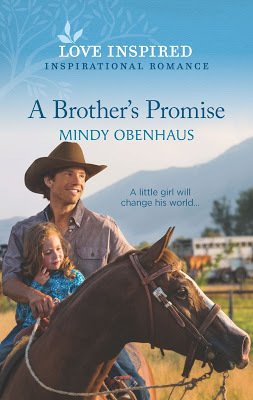
A BROTHER'S PROMISE
He didn’t realize he wanted a family… Until he suddenly became a single dad.
After his sister’s death, rancher Mick Ashford’s determined to ensure his orphaned niece, Sadie, feels at home. And accepting guidance from Christa Slocum is his first step. But just as Christa and Sadie begin to settle into Mick’s heart, Sadie’s paternal grandparents sue for custody. Now Mick must fight to keep them together…or risk losing the makeshift family he’s come to love.Get your copy HERE!Read the first chapter here.

Coming on Wednesday, March 3! Braced for Love Book one--Brothers in Arms series
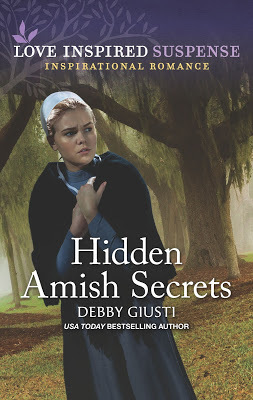
HIDDEN AMISH SECRETS Her temporary Amish homecoming could get her killed. Julianne Graber left her Amish life behind after a family tragedy, but now she’s back to sell the family home— and someone’s dead set on getting rid of her. With her neighbor William Lavy by her side, Julianne must uncover dangerous secrets to make sense of the past and present. Can she find justice for her family—and a future with Will—before the killer hits his target?March 2021Available for Pre-Order HERE!

Archetypal Character Arcs, Pt 3: The Hero Arc by KM Weiland at Helping Writers Become Authors
A Cliche Simile is a Bad Simile by Bob Hostetler at Steve Laube Agency
5 Tips on Writing a Short Story by Rachelle Shaw at Fiction University
Writing the Enemies to Lovers Trope by Hannah Bauman at Between The Lines Editorial
How to Overcome Indecision by Peter Leavell at Learn How To Write A Novel
4 Ways to Unlock Your Character's Unique Voice by Lewis Jorstad at The Novel Smithy
Plans vs Goals vs Resolutions vs Intentions at Bullet Journal
8 Great Reasons to Join a Writing Group Online by DiAnn Mills at Book Brush Blog
Is Self-Publishing a Good Choice for Your Novel by Jacquelyn Lynn at Live Write Thrive
How to Avoid an Editing Nightmare by James Hall at Write To Done
February 25, 2021
Natural Ebb and Flow: What's Your Word Count?

by Pam Hillman
Hello Seekerville. This is a repost from six years ago. But I have a good reason. My 5th grandbaby was born this week and I've been taking care of his two older sisters. Okay, it's a full-time job! Oh, and next month I'll return to my series of posts about DIY Graphics Design focusing on book covers.
I might not be around much today, at least early in the day. Mom, Dad, and baby brother should be home today, so I should be available later in the day to comment.
So, let's dive in to today's post. Some of the Seekers mentioned have retired from Seekerville, but not necessarily from writing.
Have you discovered the natural ebb and flow to your writing? Your rhythm? Your pacing? I’m not talking about the story you tell and how you tell it, but how long your scenes are. The mechanics, if you will.
Do you tend to write all your scenes the exact same length or do your scene lengths vary, coming in and out, long and short, like the tide?
I realized several years ago that I write 800 words between scene breaks. Don’t confuse a scene with a scene break. A scene break (SB) usually occurs when I change POV, not necessarily when I get to the end of a scene. It’s just how I plot. But that doesn’t mean that all my scenes are anywhere near 800 words. Some of them are far, far from that, ranging from 260 words to a whopping 1888 on my latest manuscript. I wondered if that was normal for all authors or not.
After reviewing several of my own manuscripts and getting feedback from some of my Seeker friends, I’ve come to the conclusion that varying scene length is the norm, and actually, a good thing. (Whew, glad to know I’m normal in at least one way!) But, honestly, I imagine most of you already knew that scenes varied greatly in the stories you write and those you read, yes?
But what I hope to share with you today might help you in the planning stages of your current novel…or the next one.
So, let’s get started!
If you’ve written two or three manuscripts, you probably have discovered your rhythm already. Being a spreadsheet junky, I already had my manuscripts logged in as words per scene and chapter. I knew going into my latest full-length manuscript, The Promise of Breeze Hill, that I write 800 word scene breaks (SBs). I knew the total word count needed to be about 90K. That comes out to about 112 scenes. This kind of information helps me plan where my major turning points will be.
 The Promise of Breeze HillAfter I charted the scenes for The Promise, I wondered if my last full-length manuscript had a similar rhythm. So I charted Claiming Mariah, and sure enough, the average words per SBs in Claiming Mariah was 798.22 words. The Promise of Breeze Hill was 799.75 before the rewrite. Hard to believe that the word count between SBs was so close.
The Promise of Breeze HillAfter I charted the scenes for The Promise, I wondered if my last full-length manuscript had a similar rhythm. So I charted Claiming Mariah, and sure enough, the average words per SBs in Claiming Mariah was 798.22 words. The Promise of Breeze Hill was 799.75 before the rewrite. Hard to believe that the word count between SBs was so close.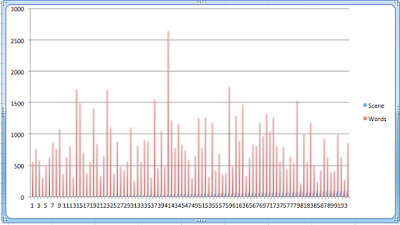 Claiming Mariah
Claiming MariahSo I wondered if other authors have similar rhythms? Even if they don’t chart their word count, if they’ve written very many books, they probably have figured out their rhythm. So, I went to the group I always go to when I have a question like this. My Seeker Sisters, of course.
Tina Radcliffe said that she tends to write two scenes per chapter for her category romance, with those chapters averaging 3500 words. Mary Connealy and Missy Tippens also said their chapters average about 3500 words. Depending on how many scenes they write per chapter, their SBs could occur every 900-1750 words or so. In spite of my spreadsheet tendencies, even my chapter lengths run the gamut of 1500 to 3500 words. Julie Lessman also mentioned that she’s writing shorter chapters these days, trying to keep her chapters to 2000 words.

Having the above information from these ladies was gold, but it didn’t tell me what I wanted to know. This only gave me averages. I wanted to see the ebb and flow of someone else’s work. Was I the only one whose charts looked like the tide rolling in and out? What really made me sit up and take notice was when fellow spreadsheet queen Myra Johnson send me some REAL LIVE DATA from two of her manuscripts. Remember up above that I mentioned that my average words between Scene Breaks (SBs) was 800 words and how knowing that helps me determine from the get-go how many scenes I need to plan on? It also helps during writing if I’m halfway through the manuscript and only have 30% of my words. I’m either not digging deep enough — or — let’s face it…. I’m not digging deep enough.
Well, turns out Myra’s average word count between SBs is right at 1050. Myra sent me the word counts per scene for Castles in the Clouds and Rancher for the Holidays. Castles is a much longer book that Rancher, but regardless, Myra’s natural “rhythm” held true.
And, her charts look like a tide rolling in and out. Just like mine!
I.Am.Vindicated!
 Castles in the Clouds by Myra Johnson
Castles in the Clouds by Myra Johnson
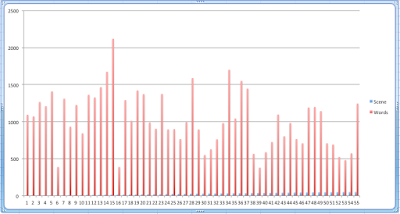 Rancher for the Holidays by Myra Johnson
Rancher for the Holidays by Myra JohnsonNow, if you’ve read this far, and you’re frantically counting and comparing words in your manuscripts, DON’T.
Knowing your natural rhythm might be good for some, and others might not care at all. I like knowing that I need to shoot for 800 word scenes. And since I write in Scrivener, I can see at a glance which scenes are low on the word count. Even though I ended up with several scenes under my goal, I strive to up the word count on those to at least 600, but at some point, some of those scenes just felt done, you know? There wasn’t a single thing I felt I could add to them to make them better. They were short, to the point, and didn’t need “padding” just to make them longer. Sometimes, you just gotta say what you need to say, and get out of there.
And that might be MY cue to wrap this up. So, a few final thoughts and tips.
Don’t force yourself to write like someone else. Don’t take one of my charts or Myra’s charts and try to write scenes to that length. That’s a recipe for disaster.
Don’t force yourself to write long/short/long or short/short/long just because you read a piece about it here. Do what comes naturally to YOU. However, if somewhere along the way in your writing, you find that something isn’t quite right or the pacing seems off, then checking your scenes for ebb and flow might be the ticket to unlocking a tsunami of great writing.

If you’re new to writing, don’t take this as gospel. Don’t even try to grasp this technique or emulate it. Tuck it away and after you’ve organically written three or four manuscripts, then compare your own work against itself to see if you see a pattern starting to emerge. I didn’t have time to chart some of my earlier manuscripts that weren’t written in Scrivener, but I glanced over a few scenes and noticed that my scenes tended to be more uniform in my earlier completed manuscripts. I think that was my way of writing to the market and what I’d analyzed in my own reading more than to my own rhythm.
It’s also important to point out that in the charts above, there is usually one scene that stands out above all the rest. While I can’t speak for Myra’s work, I will tell you that in my own, those scenes are major turning points in the story — watershed moments, if you will. Those tend to write themselves.
And, finally, one other thought. I checked a couple of my novellas and my scenes average about 575 words between SBs. Mary also mentioned that her chapters and scenes tend to be shorter in novellas. So instinctively, our rhythm for novellas is different to our rhythm for book-length fiction. More than likely yours will be too.
Did I leave anything out? Did I confuse anyone? The floor is open for discussion! :)
If you know your natural rhythm for scene length, we’d love to hear it. And, if you know the range of your scenes, even better!

CBA Bestselling author PAM HILLMAN was born and raised on a dairy farm in Mississippi and spent her teenage years perched on the seat of a tractor raking hay. In those days, her daddy couldn't afford two cab tractors with air conditioning and a radio, so Pam drove an Allis Chalmers 110. Even when her daddy asked her if she wanted to bale hay, she told him she didn't mind raking. Raking hay doesn't take much thought so Pam spent her time working on her tan and making up stories in her head. Now, that's the kind of life every girl should dream of. www.pamhillman.com
February 23, 2021
Cate's Favorite Writing Books Series - #1
Hello my Seekerville friends. Cate back again. These months just fly by, and suddenly it's my turn to post again. Honestly, it feels like just yesterday that I was chatting with you all about your feelings about craft books.
There was a wide range of thought on the value of craft books for a writer. No surprise there. Our thoughts are as varied as our personalities and our writing styles. One refrain that was oft repeated though was people, who like me, use craft books as a jumping off point to take a new skill and then practice it with our own writing.
After that discussion, I decided to devote some time to discussing some individual books that I love. I can share them with you, and you can tell me if they're new to you or if you know them and have thoughts of your own to share.
As I mentioned above (and in the previous post), I tend to use writing/craft books more as a jumpstart than as something to read through all at once. There is however, one notable exception to that pattern.
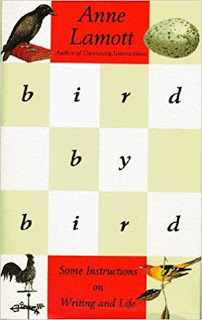 This is the old faithful one I have.
This is the old faithful one I have. I've been through multiple copies.
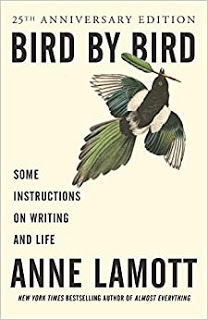 This is the new version.
This is the new version.
Bird by Bird was one of the very first books on writing that I ever bought. It is also the only one that I have read and reread completely. It was really life-changing for me because reading Anne LaMott's witty, somewhat irreverent, brutally honest reflections on the writing life allowed me to acknowledge that I could still be a writer even if I was not always in love with the process.
Writing is hard work, and Anne LaMott doesn't flinch from that.
But she also gives you ways to help cope when it all seems overwhelming.
One of the best pieces of advice in the book refers to a story from when Anne and her brother were young. He was totally overwhelmed by a school project on birds. She describes how he was sitting at the table, surrounded by piles of books and paper and pencils. Her father came and sat beside him, put his arm around him and said, "Bird by bird, buddy. Just take it bird by bird."
It seems so simple, but for the struggling writer or student, Maybe that struck such a chord because I remembered a similar project when my daughter was in 5th grade. We were up until 5 o'clock in the morning because the project was so massive that it overwhelmed her to the point she had no idea where to even begin.
I have quoted that bird by bird solution to many people over the years. In fact, I just offered it to my daughter the other day when she was again feeling overwhelmed with a big project she has to deal with.
Hand in hand with the 'bird by bird" strategy of writing comes advice to write in "one inch picture frames" - another strategy to help the overwhelmed writer's brain.
Have you ever sat down to write but felt totally overwhelmed by the size of the project? Do you find attempting a full length novel to be daunting? If so, this strategy may help you. To quote Anne Lamott, all you have to do is "write down as much as you can see through a one-inch picture frame."
 I remember a tweet from my editor Emily Rodmell that went like this:
I remember a tweet from my editor Emily Rodmell that went like this:"How do you write three books a year?
One book at a time, one chapter at a time, one page at a time, one word at a time."
In the same vein, Anne Lamott quotes E.L. Doctorow. "Writing a novel is like driving a car at night. You can only see as far as your headlights, but you can make the whole trip that way."
This reminds me very much of how writers rave about typing on an AlphaSmart because they could only see a very small rectangle of text. The temptation to fiddle was not as great.

Those two pieces of writing advice are in just one chapter of the book. They're the two that have stuck with me even though it's been decades since I first read the book. There is plenty more to keep you inspired.
Because I like to share books I love, I'm offering to give away a copy of Bird by Bird to some lucky reader who is interested. Be sure to let me know in the comments if that is you!
So have you read this book (or any of the author's other books)? Share your thoughts on the book, the advice, or anything else you feel like talking about.
Coffee's on. Let's chat!

Free photos thanks to Pixabay
February 21, 2021
The Beauty of Collaboration
Happy Monday, SeekerVillagers! For those of you in parts of the country where bitter cold was an unexpected and unpleasant guest, I hope things have warmed up, that you have power and water at your house, and that you didn't suffer too much damage. For those of you like me, who live in the frozen tundra of the north, it's nearing the end of February, and spring will come! Who was it who said, "Winter doesn't last forever, no spring misses its turn."?
Or better yet:
“As long as the earth endures, seedtime and harvest,
cold and heat, summer and winter,
day and night will never cease.” Genesis 8:22
During the rough weather in the middle of February, you should have read the emails flying back and forth amongst the Seeker-sisters. Reporting in safe, inquiring as to conditions, giving advice, prayers, information. With Seekers scattered from New York to Georgia, Mississippi, Nebraska, Colorado, South Dakota, Texas, Minnesota, DC, Arizona, Indiana...who am I missing? there were lots of varied experiences with the weather. And each SeekerSister was right on the ball with doing what they could via prayer and advice to help.
Which got me to thinking about our writing communities and how we need each other. We are not alone in our triumphs or troubles when we have a strong writing community of friends. (Wouldn't that make a great tweet?)
I've been noodling this idea of collaboration and community recently. I have taken part in several collaborations throughout my writing career. Sometimes I've collaborated on a writing project, like the Seven Brides for Seven Texans novella collection. Seven authors, writing about one family of seven brothers, the stories all taking place over one calendar year. That was a lot of collaboration!
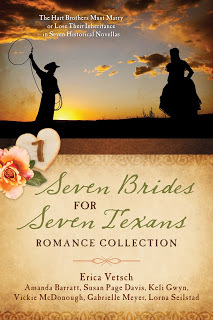
Then there is the Seekerville collaboration. As mentioned above, it's more than the blog, it's the community we've created, both with each other and with our faithful readers. (That's YOU, by the way!) Collaborating on the blog means that no one person has to provide the content every day. It means we share responsibilities both on the blog and behind the scenes. We also share ideas, guest posts, and more. We also promote the blog posts on our various platforms. I love that we support and care for each other, that there is always someone available with writing advice, life advice, and the occasional "Pull yourself together and get on with the job" advice that I need. (Looking at you, Ruthy, on that last one!)
There is also the marketing aspect of collaboration with other authors. As you know, authors are called upon more and more to do some of the heavy lifting when it comes to marketing their books. Which can get tough, especially on a budget. But when you collaborate with other authors to promote your work, it suddenly can become much easier. And here's why:
1. Shared cost. Marketing can cost you some dough. Whether it's placing ads, running giveaways, acquiring swag, the costs can add up. However, if you join with other authors who write the same sorts of things you do, you can share costs. I recently collaborated with a group of Christian fiction authors in a Love Through The Ages promotion where the prize was a set of EIGHTEEN books. And there were TWO Winners. My portion of the prize is two copies of one of my books. If I was to run a contest where I had to provide and mail THIRTY-SIX books, that would be cost-prohibitive, but I can provide and mail two books, no problem.
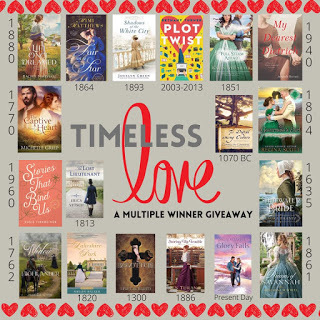
2. Shared work. Not all authors have the same strengths. Some are great at making graphics. (Looking at you, Pam Hillman.) Some are great at coming up with unique marketing ideas. Some are great with spreadsheets. Some are great at putting together ad copy. Some are great at coming up with just the right prize that will have readers eager to jump onboard. There are a lot of details to consider when you want to do a promotion, and no author is an expert in all of them. When you pool your abilities, more aspects can be covered that you might not have thought of on your own, and no one author has to be in charge of everything. You are all links in a chain that stretches farther (further? Farther? Sigh. My constant struggle.) than a single link could on its own.

3. Shared information. Did you know that Mary Connealy is possibly the best in the world at finding useful book swag? Hairbrushes, jar openers, cutting boards, letter openers, chip clips...these are just a FEW of the amazing things she has found for reasonable prices that enable her to promote her books on something that readers will keep and use. She lets us know her sources and we kick around ideas for what would be good to purchase in the future. Some authors are more up to date than I am on where good places to advertise might be. How to promote posts on FB, or buy ad space on amazon or get a post in a magazine publication. We each possess bits of information that can and would be useful to our collaborating authors, and sharing it means more people hear about your work.

4. Shared reach. The number of people in your newsletter list, your FB friends list, your Instagram friends, etc. is known as your "Warm Reach." These are the people to whom you have access, and that you can inform fairly easily about your books. But here's the thing, Winnie Griggs has people in her 'warm reach' that I do not. The same with Mindy Obenhaus, Missy Tippens, Debby Giusti, and Beth Erin. When we collaborate on a promotion, marketing, giveaway, whatever, the information about their books and services reaches people on my list that otherwise wouldn't know about it, and vice versa. I call it 'cross-pollination.' The above Love Through The Ages collaboration resulted in several HUNDRED new email subscribers for me that I would have had no way to reach otherwise, and those new newsletter friends came as a result of the seventeen other authors promoting the giveaway to their 'warm reach.'

5. Shared fun. Face it, writers like to talk to other writers, and to brainstorm, and to be creative. Twice last year, author friends Julie Klassen and Michelle Griep and I collaborated on a fun promotion called Regency Bingo. We invited folks to choose Regency-themed words from a list, email their chosen words to a third party, and then Julie, Michelle and I filmed ourselves drawing words from the Top Hat of Awesomeness, three words each day until all the words were drawn. The first person to have their chosen words pulled from the hat, emailed the third party with a BINGO, and won a prize. The response to the game has been phenomenal. Everyone has a great time, including us. If you could see us behind the scenes when we're filming...it's a load of fun! We'll do the promotion again, and each time we'll add a new twist to keep it fresh.

Now, not all collaborations are created equally, and you need to evaluate the ROI. Return on Investment. Some collaborations will cost you very little, but they might bring you a nice return. Ultimately, you're looking for each promotion you do to result in a wider audience for your books. Whether that is through newsletter contacts, social media reach, or even better, new friends, you are hoping for some return on the investment you're making. Some collaborations might cost you a lot in time. You must choose whether you feel the time invested in the collaboration will give you a decent return, or if your time might be better spent another way.
You'll learn from each collaboration, and you'll teach others, too. And you'll find that working with others toward a similar goal means you will be 'greater than the sum of your parts.'
Have you collaborated with others to increase the effectiveness of your efforts? Do you feel it was successful? Did you learn a lot?

Best-selling, award-winning author Erica Vetsch loves Jesus, history, romance, and sports. She’s a transplanted Kansan now living in Minnesota, and she is married to her total opposite and soul mate! When she’s not writing fiction, she’s planning her next trip to a history museum and cheering on her Kansas Jayhawks and New Zealand All Blacks. You can connect with her at her website, www.ericavetsch.com where you can read about her books and sign up for her newsletter, and you can find her online at https://www.facebook.com/EricaVetschAuthor/ where she spends way too much time!
FYI, Book 3 in the Serendipity & Secrets series drops in just about one month! Do you have your copy pre-ordered?

Can Captain Wyvern keep his new marriage of convenience all business--or will it turn into something more?
Captain Charles Wyvern owes a great debt to the man who saved his life--especially since Major Richardson lost his own life in the process. The best way to honor that hero's dying wish is for Wyvern to escort the man’s grieving fiancée and mother safely to a new cottage home by the sea. But along the way, he learns of another obligation that has fallen on his shoulders: his uncle has died and the captain is now the Earl of Rothwell.
When he and the ladies arrive at his new manor house in Devon, they discover an estate in need of a leader and a gaggle of girls, all wards of the former earl. War the new earl knows; young ladies and properties he does not. Still wishing to provide for the bereaved Lady Sophia Haverly, Charles proposes a marriage of convenience.
Sophie is surprised to find she isn't opposed to the idea. It will help her care for her betrothed's elderly mother, and she's already fallen in love with the wayward girls on the Rothwell estate. This alliance is a chance to repay the captain who has done so much for her care, as well as divert her attention from her grief. When Wyvern returns to his sea commission, she'll stay behind to oversee his property and wards.
It sounds so simple. Until the stalwart captain is arrested on suspicion of smuggling, and Sophie realizes how much he's come to mean to her. Now she'll have to learn to fight, not only for his freedom but also for his love.
Pre-order today at: amazon or ChristianBook or B&N or ChristosBookCenter (This last one is the local Christian bookstore in my town. If you're wanting to support local, but you don't have a local bookstore, give Erika Kelly a call at Christos. She will lovingly serve and get you just what you need!)
February 20, 2021
Sunday Scripture & Prayer Requests
First Sunday in Lent Christ in the Wilderness, Ivan Kramskoi, 1872,
Christ in the Wilderness, Ivan Kramskoi, 1872,
Tretyakov Gallery, Russia. [PD-US]
The Spirit drove Jesus out into the desert,
and he remained in the desert for forty days,
tempted by Satan.
He was among wild beasts,
and the angels ministered to him.
After John had been arrested,
Jesus came to Galilee proclaiming the gospel of God:
“This is the time of fulfillment.
The kingdom of God is at hand.
Repent, and believe in the gospel.”
Mark 1:12-15
The Seekerville bloggers are praying for YOU and for our entire blog community. If you have any special intentions that need additional prayer coverage, leave a request for prayer in the comment section below.
Please join us in praying for the United States--and the world--during the current rise in Coronavirus cases. Pray for the sick and suffering, for businesses and schools to remain open, for people to be able to work and for our economy to prosper.We are so grateful for all of you—for your friendship and your support!
May the Lord bless you and your families and keep you safe.
Let us know if you've been impacted by the recent storms. We've been praying for all who have been without power and water...and for the entire state of Texas! Also we've been praying for those blanketed with snow and for the areas devastated by tornadoes.
Stay safe, dear friends!
February 19, 2021
Weekend Edition


If you are not familiar with our giveaway rules, take a minute to read them here. It keeps us all happy! All winners should send their name, address, and phone number to claim prizes. Please send to Seekerville2@gmail.com. If the winner does not contact us within two weeks, another winner may be selected.
Monday: Jan Drexler
Wednesday: Debby Giusti blogged on Ash Wednesday about "Writing & the Lenten Journey!" Thanks, everyone, for stopping by and joining in the discussion.
Friday: Winnie Griggs discussed tips and considerations for adding subplots to your story. Check back here shortly for the name of the individual who won a copy of one of her backlist books.

Monday: Erica Vetsch will talk about the beauty of collaborating with others in our marketing endeavors.
Wednesday: Cate Nolan will be here talking about one of her favorite writing books - but you'll have to come by on Wednesday to find out what it is and have a chance to win a copy. Friday: Pam Hillman

Releases Tuesday!

A BROTHER'S PROMISE
He didn’t realize he wanted a family… Until he suddenly became a single dad.
After his sister’s death, rancher Mick Ashford’s determined to ensure his orphaned niece, Sadie, feels at home. And accepting guidance from Christa Slocum is his first step. But just as Christa and Sadie begin to settle into Mick’s heart, Sadie’s paternal grandparents sue for custody. Now Mick must fight to keep them together…or risk losing the makeshift family he’s come to love.Available for preorder HERE!Read the first chapter here.
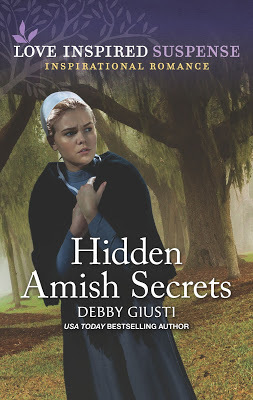
HIDDEN AMISH SECRETS Her temporary Amish homecoming could get her killed. Julianne Graber left her Amish life behind after a family tragedy, but now she’s back to sell the family home— and someone’s dead set on getting rid of her. With her neighbor William Lavy by her side, Julianne must uncover dangerous secrets to make sense of the past and present. Can she find justice for her family—and a future with Will—before the killer hits his target?March 2021Available for Pre-Order HERE!

8 Ways to Defeat Writer's Block by LA Sartor at Book Brush Blog
6 BookBub Ad Features You May Not Know About by Carlyn Robertson at BookBub Partners
Get Reader Reviews Now to Drive Sales Later by Mike O'Mary at Jane Friedman
Backstory: Dodging the Info Dump by Lori Freeman at Writers In The Storm
Tips on Brainstorming by Susan May Warren at Learn How To Write A Novel
Why Rescuing Your Protagonist Might be a Terrible Idea by Janice Hardy at Fiction University
Using Instagram Stories to Grow Your Reader Audience by Christina Kaye at Book Brush Blog
7 Expert Tricks to Improve Your Author Newsletter by David Gaughran
Is Your Writing Terrible...Or Is It The Dunning-Kruger Effect? by Scott McCormick at Book Baby Blog
Archetypal Character Arcs, Pt 2: The Maiden Arc by KM Weiland at Helping Writers Become Authors
Finally...Don't miss this month's Inside Edition by Tina Radcliffe! Filled with information for writers including Twitter Pitch opportunities, monthly agent spotlights, contest, conference, workshop listings and so much more. Join the newsletter now.
Writing Subplots
.

Hello everyone, Winnie Griggs here. Today I wanted to talk a little bit about subplots.
First, let’s define what a subplot is.
According to the Cambridge dictionary a subplot is “a part of the story of a book or play that develops separately from the main story” Some call it the B Story, the minor story or the secondary story line. But whatever you call them, they are minor story and/or character arcs that support and enhance your main story line by adding texture, context, complexity and richness to it.
So why use subplots?
Subplots, when done effectively, add additional depth, texture, richness and dimension to your story. They do this by adding conflict, romance, tragedy, mystery, tension, additional worldbuilding and other elements. In some cases they can add critical information your protagonists in the main story thread may be unaware of.
Some of the ways subplots do this:
They add another layer of verisimilitude to your story. After all, people don’t live in a vacuum, they have more than one thing going on in their lives and more than one person/team of people tugging at their attention. Sub plots can help show that interaction for your protagonists.They help add page count without your story feeling padded or episodic.They can help illustrate or up the stakes.They can improve characterization by allowing the reader to see your protagonist through another set of eyesIf you’re writing a series, they can help bring in beloved characters from previous books, or introduce characters that will appear in future books.For mysteries or stories from other genres with a touch of mystery, they can introduce red herrings or obfuscate clues.They can help fine tune the pace of your story, inserting lighter moments into a tense main plot or vice versa, providing your reader with a breather between high octane They can serve to temporarily detour, delay or change your protagonists goalsThere are others but we’ll leave it there for now. By the way, if you can make one subplot perform more than one of these functions it will make your subplot

Does every story need a subplot?
Of course short stories don’t. As for longer works, while there are no hard and fast rules when it comes to writing, the truth is that even stories that manage to stand alone with one main plotline can benefit from having a subplot or two, for all the reasons listed above.
So let’s dig into the various Types of Subplots
Romantic SubplotsIf you’re writing a romance, you can add a secondary romance between Secondary characters. This is often seen in Hallmark movies, the heroine’s best friend finds love while the main characters are still dancing around the issue.
If you’re writing any other genre, adding a love interest for your protagonist as a subplot can add interest and complications to your main plot
Mirror Subplots
These are subplots that are similar to or ‘mirror’ some aspect of the protagonists story arc. This is one way to show the stakes. For instance perhaps you have a protagonist who is standing up to a corrupt land developer as is his neighbor. If his neighbor has his home burned to the ground, that graphically illustrates the kind of stakes the protagonist is facing
Contrast Subplots
The opposite of Mirror Subplots, these show what happens when a secondary character makes different choices than your main character. For instance, your protagonist might have chosen to go into the family business after high school, while his brother chose to head to college across the country. Your subplot could illustrate the consequences, positive and/or negative, of those choices.
Complicative Subplots
Subplots that get in the way of your protagonists achieving their goals are a great way to keep the tension and conflict high and the reader turning the pages.
Comedic Subplot
This is a subplot that is intended to lighten the mood and give the reader a chance to smile or take a breath from whatever is happening in the main storyline. Take care when crafting this type of subplot – the timing, genre and overall tone of the story needs to be carefully considered when deciding if your comedic element is appropriate.
Character Revelation
These subplots reveal additional attributes of your story’s protagonists. They can showCharacter FlawsCharacter StrengthsCharacter Backstory
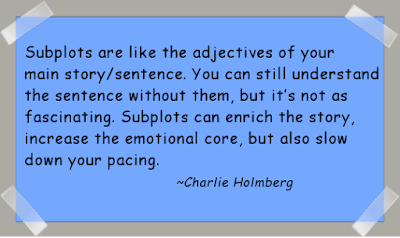
How to craft your subplot
The number one thing to remember is that the subplot is just that – subordinate to the main plot. Its sole purpose is to enhance some aspect of the main plot. There should never be any confusion as to which is the main plot and you will want to wrap up all of your subplot threads before the main plot. The only exception to this is the subplot that is going to arc over several books in a series.
Craft your subplot as a mini-story in its own right with an arc of its own – it should have a beginning, middle and end of its own.
Make certain you know how your subplot ties into your main plot. It can run parallel to it, weave in and out of it or be plopped in in one chunk. Any of these methods can work as long as it does its job of enhancing the main story line.
The timing of introducing and ending your subplots are important to the pacing of your story. You want to maintain the momentum and page turning aspect as much as possible. When the main plot line slows or lags, introducing or returning to a subplot can propel your reader forward.
Make sure you understand the purpose of your subplot. How will it relate to and enhance your main plot. What questions will it raise and/or answer for your protagonists and their goals.
Also make certain the subplot is necessary. Does the function it performs require a subplot or could it b handled more effectively in a different way?
As for the mechanics, as I was researching tis topic, I discover that some writers plot (at a high level) the main plot and each subplot separately, treating each subplot as a separate, simpler story. Once that’s done then they take each subplot, break it into scenes and then see where those scenes fit within the main story. I’ve never actually approached plotting this way, but I find the idea intriguing and may just try it next time I begin plotting a story.
Final Thoughts
There’s a whole lot more than can be said about subplots but I’ll leave it there.
I’ve heard subplots described as connective tissue for your story and I like that description. If you look up the medical aspects of connective tissue you’ll find this: The five major functions of connective tissue include:
binding and supporting other tissue in the body, protecting, insulating, storing reserve fuel, and transporting substances within the body.If you replace the word body with the word story you’ll see that subplots can do all of those things.
So when planning your next story, give some careful consideration to what subplots can do if you deliberately and effectively weave them into the fabric of your story (and yes, I know I missed my metaphors)

So let's hear from you. Do you like having subplots in a story?. Can you think of other functions subplots perform or other tips and tricks for crafting them? Do you have a favorite kind of subplot?
Comment to get your name in the hat for your selection of any book in my backlist.
February 16, 2021
Writing & the Lenten Journey
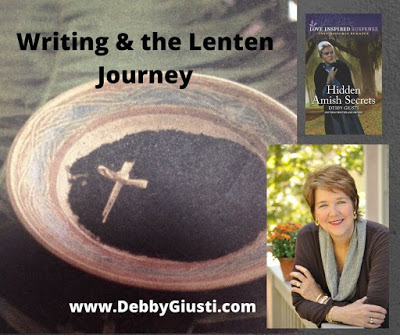
By Debby Giusti
Today marks the beginning of Lent, a special time for Christians to draw closer to God. When we deny ourselves through fasting, when we turn our hearts more fully to the Lord through prayer, and when we put the needs of our brothers and sisters before our own wants through almsgiving, we are able to more fully enter into the Paschal Mystery. As many of us can attest, a well-lived Lent leads to a joyous Easter.
Incorporating fasting, prayer and almsgiving into our daily lives unites us more intimately with Christ who spent forty days in the desert to prepare for his public ministry. Giving up a favorite food or beverage is a sacrifice that reminds us of our human nature and the creature comforts that sometimes steer us off track. By denying ourselves, we turn our focus from the earthly realm to the spiritual.
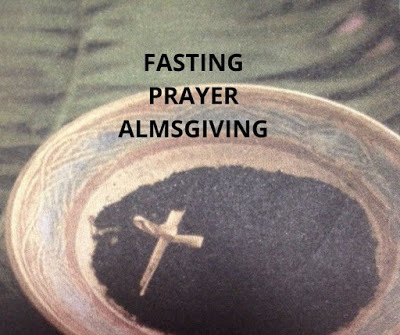
Fasts can take many forms. Some folks fast from a favorite television show, from online games, or even from Facebook, Twitter or other social media. Filling that freed up time with prayer, scripture, or other spiritual readings, helps us deepen our personal relationship with Christ. As we come to know him better, we can love him more.
The church has always talked about a preferential option for the poor that is so clearly defined in the Gospels. Christ reached out to the poor and needy, and we are called to do the same. Giving to charities, stocking food pantries, feeding and clothing the homeless and aiding neighbors in need are some of the many ways we can help the poor and marginalized. Habits we start in Lent often continue as life-long ministries that spread God’s love and allow us be the hands and feet of Christ.
Since this is a Christian blog, I’m sure many of us embrace some type of Lenten practice, so you might be asking, what does this have to do with writing?
Writing takes determination and perseverance. Creating stories is exciting, but the day-to-day battle to get words on the page can be a challenge. If you’re having trouble completing a project, I suggest setting a Lenten goal. Perhaps increase your daily word count and offer that to the Lord. If we believe he has called us to write, then our writing can be offered up as a gift to him.
The COVID outbreak has isolated so many folks, especially the infirmed and the elderly. Think about sending a cheery note to a shut-in or a card of encouragement to a homebound mom who’s struggling to help her children with their virtual learning. Words of comfort mailed to grieving families who, because of the pandemic, weren’t able to be with loved ones when they passed is another way of spreading Christ’s light and can be a meaningful Lenten practice.
Have you heard a little voice encouraging you to write something outside the box? Something different from your usual genre? Could that voice be God prompting you in a new direction? What better time than Lent to offer a new endeavor to the Lord. When we invite him into our world and into our writing, we often find new blessings as we follow his inspiration.

So much has changed over the last year. Early in 2020, we realized a strange and virulent virus was making its way around the world. We hunkered down in our homes, we donned masks, we feared contact with other people and we waited to see how devastating the pandemic would be. We’ve learned a lot in the last twelve months and, thankfully, have a clearer understanding of the pathogenicity of the virus and better protocols for treatment of the sick.
Yet, negative side effects from the pandemic occurred as we sheltered at home and relied on others to make decisions for our wellbeing. Perhaps you’re questioning some of the decisions that have altered our way of life. Are you a parent wondering when your children will go back to school? Are you a small business owner trying to keep your company afloat or a restaurateur who had to shut down because of dining restrictions? Are you seeing those who make the rules break the rules? Does that disparity upset you? If so, are you being called to voice your concerns? The Lord may be asking you to use your writing ability to call out some of the hypocrisy that continues to prevail.
I’m concerned about the attack on our Freedom of Speech. Big Tech has turned into a truth regulator that silences ideas that do not align with what they believe. With a background in clinical science, I try to stay current on the virus, treatment, vaccines and the truth about mask wearing. Too often, voices—even well-established medical professionals—are removed from public forums if their message differs from those tasked to guide our nation. Why are those scientific videos and reports taken offline?
Does anyone remember the McCarthy witch hunt in the 1950s? Have you read George Orwell’s 1984? Remember Big Brother in that story? As a writer who deals in words, I am concerned by censorship that limits free speech, whether I espouse the ideas removed from the public domain or not. If medical information is censored today, what will be censored tomorrow? Our Freedom of Religion is also under attack. Will those attacks increase in the days ahead, and if so, will Christian fiction be targeted in the future?

This Lent, I’m prayerfully reflecting on ways I can stand up for Freedom of Speech. I’m only one person, but if everyone spoke up when they saw something that was wrong, the world would be a better place.
Is the Lord calling you to write for him this Lent? To write something that will spread his message of love and mercy? Is he asking you to reach out to someone in need or to speak truth to power or to take a stand against some form of evil?
Grab a cup of coffee and let’s discuss Lent and the ways we can serve the Lord during our Lenten journey.
Wishing you a blessed Ash Wednesday!
Debby Giusti
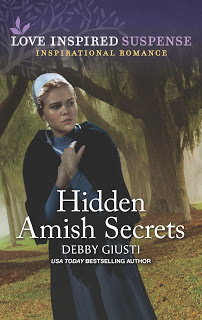
Hidden Amish Secrets
Her temporary Amish homecoming
could get her killed.
Julianne Graber left her Amish life behind after a family tragedy, but now she’s back to sell the family home— and someone’s dead set on getting rid of her. With her neighbor William Lavy by her side, Julianne must uncover dangerous secrets to make sense of the past and present. Can she find justice for her family—and a future with Will—before the killer hits his target?
Pre-Order on Amazon!



